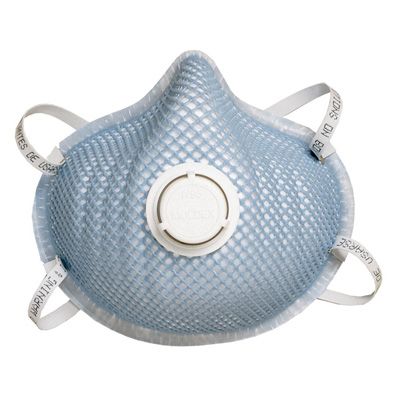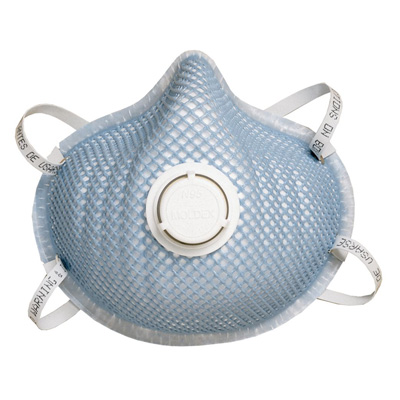
N95 Filtering Face Pieces: Where Does Your Organization Stand?

When it comes to following health and safety standards, nearly every worker tries to do the right thing. And when workers deviate from standards and best practices, it is typically due to lack of knowledge and proper training. One industry topic that is not yet fully understood and continues to be heavily debated is the N95 filtering face piece, in particular its uses and program requirements. In response, this article seeks to assist those who are involved with the development and enforcement of their organization’s voluntary respiratory protection policy.
To begin, there are two reasons why N95 face pieces are especially relevant to readers right now.
First, OSHA is currently in the process of revising the standard on crystalline silica dust, which is a common utility and construction industry hazard that is oftentimes mitigated by N95 face pieces. OSHA’s fact sheet on crystalline silica (see www.osha.gov/OshDoc/data_General_Facts/crystalline-factsheet.pdf) describes the substance as “a basic component of soil, sand, granite, and many other minerals” that workers may encounter when sandblasting, jackhammering, drilling rock or working with concrete. Clearly, many utility industry workers are exposed to most of these activities – if not all of them – on a recurring basis.
OSHA’s rationale for revising the standard is based on evidence the agency has gathered that workers are not protected from hazards associated with crystalline silica at the currently enforceable permissible exposure limit (PEL). Therefore, OSHA is taking steps to adjust the PEL. More information about OSHA’s notice of proposed rulemaking for crystalline silica exposures can be found at www.federalregister.gov/articles/2013/09/12/2013-20997/occupational-exposure-to-respirable-crystalline-silica.
N95 face pieces are also relevant at the moment because the National Institute for Occupational Safety and Health (NIOSH) will soon celebrate N95 Day. Held each year on September 5 – or 9/5, in honor of the rating of the filtering face pieces – N95 Day was developed by NIOSH as a way to promote awareness about the face pieces, including their uses and limitations. As the day approaches, more information can be found at www.cdc.gov/niosh.
The Hazard Analysis
It has been established that crystalline silica may be present on a great number of job sites, but a hazard analysis must be conducted before an organization jumps to the solution of employing N95 filtering face pieces. A typical hazard analysis can be boiled down to four key actions: identifying the hazard; adopting a mitigation strategy; implementing controls or safeguards using the hierarchy of controls; and monitoring the situation to ensure adequate levels of protection.
So, before N95 respirators are even a consideration, an organization needs to perform several tasks. First, worker exposure to crystalline silica must be identified. Second, a qualified person using the appropriate air sampling instrumentation and methods must measure the silica exposure of affected employees. And third, if the measured exposure reaches the limits imposed by OSHA in Table Z-3 of 1910 Subpart Z, the employer must take the appropriate steps to protect employees. In some cases, organizations may choose to adopt a more conservative exposure level, such as NIOSH’s recommended exposure limit.
Voluntary vs. Mandatory
It does not matter if a work site falls under OSHA’s general industry standards, construction industry standards or shipyard or marine standards. All are governed by OSHA’s general industry respiratory protection standard found at 29 CFR 1910.134. This standard – which addresses everything from the self-contained breathing apparatus used by firefighters, to the full-face and half-face respirators used by painters, to the N95 filtering face piece – is divided into two parts: The first sets forth the requirements for mandatory respiratory protection programs, and the second outlines the requirements for voluntary respiratory protection programs.
Most workers who wear respirators are required by their employers to do so. However, some organizations develop voluntary respiratory protection policies to provide guidance regarding workers who opt to use respiratory protection when it is not required, generally for the purposes of additional comfort and protection. It is important to note that even when the use of the respirators is voluntary, some provisions of the employer’s mandatory program – if one exists – may apply. For instance, workers who elect to use full-face respirators must undergo the same fit testing, medical evaluation and pulmonary testing as those required to wear full-face respirators. In contrast, N95 filtering face pieces are not nearly as taxing to the wearer or as complex in terms of policy development. Developing a voluntary respiratory protection policy for N95 face pieces will be the focus of the remainder of this article.
Drafting the Policy
Once an organization’s policy development team has been formed, a good way to start the process of developing an N95 policy is to compose a list of OSHA’s mandatory respiratory protection requirements, such as a written program, medical evaluations, fit testing, cleaning, maintenance and training.
The next step is to draw a line through any items OSHA does not require for a voluntary respiratory protection policy. For instance, there is not a legal requirement that a voluntary policy must have a written program. However, before making any final decisions about what should or should not be part of the N95 policy, be sure to read the “Policy Development Caveats” section found in this article.
You will then want to read through the face piece manufacturer’s product paperwork and identify its requirements. For example, the product manufacturer may state that a medical evaluation is necessary to ensure workers are physically capable of working with added pulmonary stress. Those requirements should be included on the list of items that must be part of your organization’s N95 policy.
When an organizational policy is being developed, many decision-makers will probe the policy from different perspectives to look for weaknesses. Given that, it is a smart idea for members of the development team to approach the policy they are drafting from the perspective of an OSHA compliance safety and health officer (CSHO). CSHOs review information and then issue citations in one of the following four ways:
1. By citing a violation of an OSHA standard.
2. By citing a standard that is incorporated by reference. In this case, it is a requirement that all respirators be approved by NIOSH. Therefore, a respirator not meeting NIOSH requirements can result in a citation.
3. By citing a violation of the product manufacturer’s requirements.
4. By directly citing OSHA Section 5(a)(1), commonly referred to as the General Duty Clause, although this practice is not preferred.
Policy Development Caveats
It should come as no surprise that, during the policy development stage, there are some caveats the development team should consider.
First, it should be noted that PPE is a worker’s last line of defense in the event that engineering controls, such as ventilation systems, and administrative controls, such as establishing isolation areas, have either failed or are not feasible. In fact, some safety professionals are of the opinion that N95 filtering face pieces should not be used at all as they foster a false sense of security. For instance, poorly trained workers could misguidedly use N95 filtering face pieces to protect against CO, CO2, H2S or oxygen-deficient atmospheres, not realizing the product is not rated to protect the wearer from these and other hazards.
The struggle between meeting the legal minimum and the effective safe working minimum is a second caveat the policy development team must consider. To illustrate, recognize that a written policy is not a bad idea even if it is not required. Many organizations are now finding themselves with a combination program in which some workers fall under a required standard when performing demolition or abatement work while other workers fall under a voluntary standard for more routine activities. For this and other reasons, some organizations may adopt a mirror policy between voluntary and mandatory respiratory protection policies. Although this may be more common with abatement groups or contractors, this approach has the benefit of streamlining training and coordinating resources.
Conclusion
As stated in the introduction, most workers try to follow safety rules, and the primary reason for deviation from compliance is typically unintentional. In this case, poor training or a lack of understanding largely contributes to the misuse of the N95 filtering face piece and PPE in general. Further, misconceptions are not strictly limited to the rank-and-file worker; they may also affect management, engineers, estimators, procurement specialists and safety professionals who are not well-versed in protection from health hazards. To compound this issue, OSHA is in the process of lowering the current PEL for crystalline silica.
Given these facts, there is no time like the present to get better acquainted with the N95 filtering face piece and its place, if any, in your organization. With NIOSH’s N95 day coming up on September 5, many additional resources will be available to aid in this effort. In closing, ask yourself: Where does your organization stand on the use of N95 filtering face pieces?
About the Author: Jarred O’Dell, CSP, CUSP, is the safety director for Syracuse Utilities and an instructor at Rochester Institute of Technology’s OSHA Education Center. O’Dell has gained 12 years of experience in the construction and utility industries since serving in the U.S. Army. He can be reached at jarred.odell@syracuseutilities.com.
Safety Management, Worksite Safety, ppe

